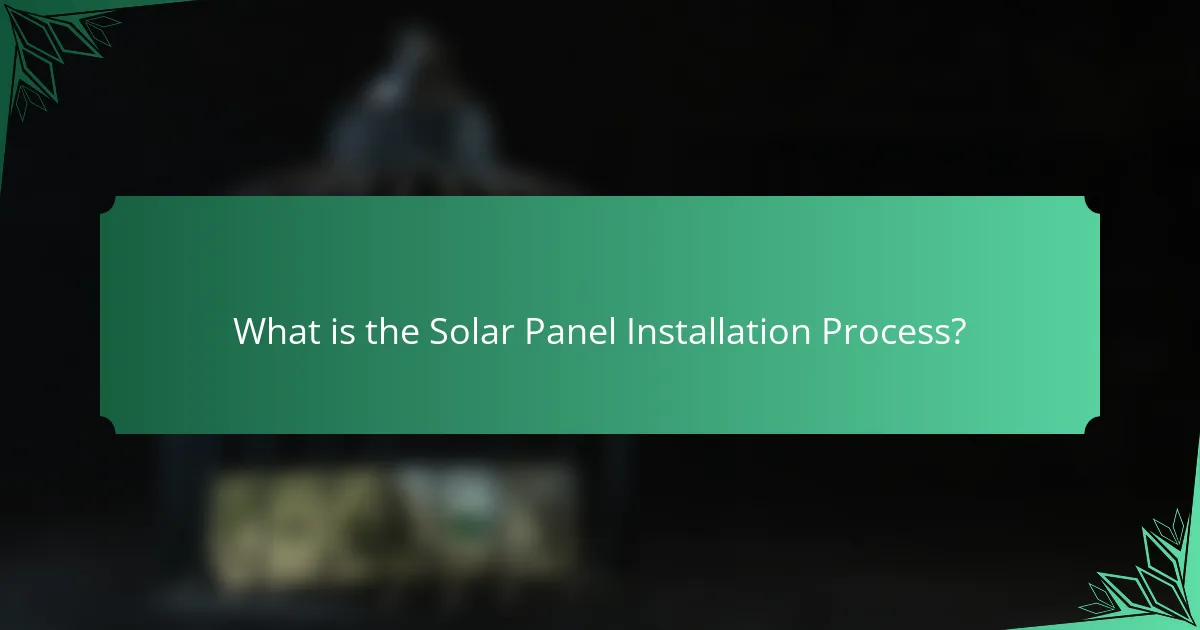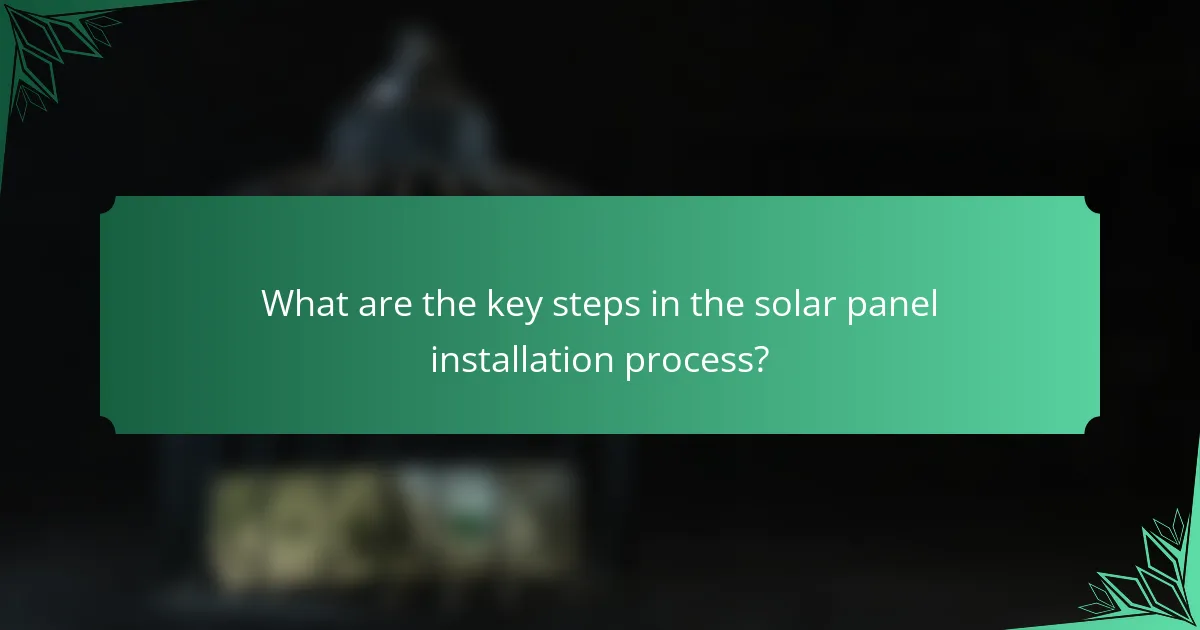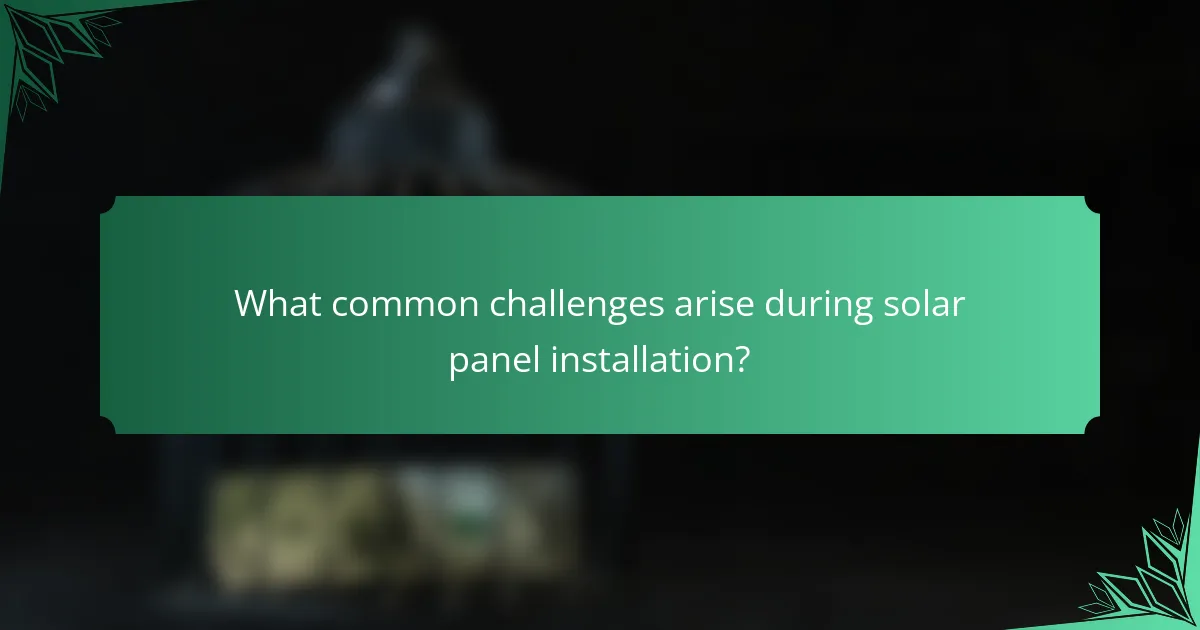
What is the Solar Panel Installation Process?
The solar panel installation process involves several key steps. First, a site assessment is conducted to evaluate the property’s suitability for solar panels. This includes checking the roof’s condition, orientation, and shading. Next, the design phase occurs, where a solar system layout is created based on the assessment. After design approval, necessary permits are obtained from local authorities.
Once permits are secured, the installation team prepares the site. This involves mounting the solar panels on the roof or ground. The panels are then connected to an inverter, which converts solar energy into usable electricity. Finally, the system is connected to the electrical grid, and inspections are conducted to ensure compliance with regulations.
According to the Solar Energy Industries Association, the average installation time for a residential solar system is one to three days, depending on system size and complexity.
How does the solar panel installation process work?
The solar panel installation process involves several key steps. First, a site assessment is conducted to evaluate the location and energy needs. Next, a system design is created based on the assessment. This includes selecting the appropriate solar panels and inverters. After design approval, permits are obtained from local authorities.
The installation begins with mounting the solar panels on the roof or ground. Wiring is then connected to the inverter and the electrical system of the building. Once everything is connected, the system is tested for functionality. Finally, the installation is completed with inspections to ensure compliance with safety standards.
This structured approach ensures that solar panels are installed efficiently and effectively, resulting in optimal energy production.
What are the key phases of solar panel installation?
The key phases of solar panel installation are site assessment, design, permitting, installation, and inspection.
During the site assessment, professionals evaluate the location for solar panel suitability. This includes analyzing roof condition, orientation, and shading.
Next, in the design phase, a system layout is created based on the assessment. This layout determines the number of panels and their placement.
The permitting phase involves obtaining necessary approvals from local authorities. This ensures compliance with regulations and safety standards.
Installation follows, where panels, inverters, and other components are physically mounted. This phase requires skilled labor to ensure proper setup.
Finally, an inspection is conducted to verify system functionality and safety. This step often includes utility company involvement to finalize connections.
What roles do professionals play in the installation process?
Professionals play critical roles in the solar panel installation process. They conduct site assessments to evaluate the suitability of a location for solar panels. This involves analyzing factors like sunlight exposure and structural integrity. Professionals also design the solar system layout based on the specific needs of the property. They ensure compliance with local regulations and obtain necessary permits. Installation teams physically mount the solar panels and connect them to the electrical system. Technicians perform testing to ensure the system operates efficiently after installation. Their expertise minimizes risks and enhances the overall performance of the solar energy system.
What are the benefits of installing solar panels?
Installing solar panels provides numerous benefits. They significantly reduce electricity bills by harnessing renewable energy from the sun. Homeowners can save thousands over time, with average savings between $10,000 to $30,000 depending on location and energy usage. Solar panels also increase property value, often adding 3-4% to a home’s market price. Additionally, they contribute to environmental sustainability by decreasing reliance on fossil fuels. According to the U.S. Department of Energy, solar energy can reduce greenhouse gas emissions by up to 90%. Furthermore, government incentives and tax credits can offset installation costs, making solar energy more accessible. Overall, the benefits of solar panels include financial savings, increased property value, and a positive environmental impact.
How does solar panel installation impact energy bills?
Solar panel installation significantly reduces energy bills. Homeowners can generate their own electricity, decreasing reliance on the grid. This can lead to lower monthly utility costs. According to the U.S. Department of Energy, solar energy can save homeowners an average of $1,500 annually on energy bills. Additionally, excess energy produced can be sold back to the grid, further offsetting costs. Over time, the initial investment in solar panels typically pays for itself through these savings. Therefore, solar panel installation has a direct positive impact on energy bills.
What environmental advantages does solar energy provide?
Solar energy provides significant environmental advantages. It reduces greenhouse gas emissions, which contribute to climate change. According to the U.S. Environmental Protection Agency, solar energy can prevent the release of over 4,000 pounds of carbon dioxide annually per household. Solar power also decreases air pollution, improving public health. Studies show that transitioning to solar energy can reduce sulfur dioxide and nitrogen oxides, which are harmful pollutants. Additionally, solar energy conserves water resources compared to traditional energy sources. The National Renewable Energy Laboratory states that solar power uses minimal water in its generation process. Overall, solar energy promotes a cleaner and healthier environment.

What are the key steps in the solar panel installation process?
The key steps in the solar panel installation process include site assessment, design, permitting, installation, and inspection. First, a site assessment evaluates the location’s solar potential. This step considers roof orientation, shading, and structural integrity. Next, the design phase involves creating a system layout tailored to the site. After design, obtaining the necessary permits from local authorities is crucial. The installation phase follows, where solar panels and associated equipment are mounted. This typically takes one to three days, depending on the system size. Finally, an inspection ensures the installation meets safety and code requirements. This step confirms that the system operates efficiently and safely.
What preparations are necessary before installation?
Before installation, it is necessary to conduct a site assessment. This assessment determines the suitability of the location for solar panel installation. Evaluating the roof’s condition and orientation is essential. Ensuring there are no obstructions like trees or buildings is also crucial. Checking local regulations and obtaining necessary permits is required. Reviewing the electrical system’s capacity ensures compatibility with solar panels. Finally, confirming the budget and financing options is important to proceed effectively.
How do site assessments influence the installation process?
Site assessments significantly influence the installation process of solar panels. They evaluate the physical characteristics of the installation site. This includes analyzing roof orientation, shading, and structural integrity. Accurate site assessments help determine the optimal solar panel placement. They also identify potential obstacles that could affect performance. For instance, shading from nearby trees can reduce energy output. Additionally, site assessments assess local regulations and permitting requirements. Understanding these factors streamlines the installation process and ensures compliance. Ultimately, thorough site assessments lead to more efficient and effective solar panel installations.
What permits are required for solar panel installation?
Permits required for solar panel installation typically include a building permit and an electrical permit. The building permit ensures that the installation complies with local building codes. The electrical permit verifies that the electrical work meets safety standards. Some areas may also require a zoning permit to confirm land use compliance. Additionally, homeowners’ associations might have specific regulations that need to be addressed. Local regulations vary, so it’s crucial to check with local authorities for specific requirements. Compliance with these permits is essential for legal and safety reasons.
What are the installation steps for solar panels?
The installation steps for solar panels include site assessment, design, permitting, installation, and inspection. First, a site assessment evaluates the location’s sunlight exposure and roof condition. Next, a design phase creates a layout and system size based on energy needs. After design, obtaining permits from local authorities is essential for compliance. The installation involves mounting the panels, connecting wiring, and integrating with the electrical system. Finally, an inspection ensures the system meets safety and performance standards. Each step is critical for a successful solar panel installation.
How are solar panels mounted on rooftops?
Solar panels are mounted on rooftops using a framework of brackets and rails. First, installers assess the roof’s structure and angle. They then secure mounting brackets to the roof, ensuring they are waterproof. Next, rails are attached to these brackets to hold the solar panels. The solar panels are then placed on the rails and secured with clamps. This method allows for proper alignment and stability. Additionally, the installation must comply with local building codes and regulations. Proper mounting ensures optimal sunlight exposure and energy efficiency.
What electrical connections are involved in the installation?
The electrical connections involved in solar panel installation include the solar panels, inverter, charge controller, and battery storage. Solar panels connect to the inverter, converting DC to AC power. The inverter connects to the electrical panel, distributing power throughout the building. A charge controller regulates the voltage from the solar panels to the battery storage. Battery storage connects to the inverter, providing backup power. These connections ensure efficient energy conversion and distribution. Proper wiring and connections are crucial for system performance and safety.

What common challenges arise during solar panel installation?
Common challenges during solar panel installation include improper site assessment, inadequate structural support, and weather-related delays. Site assessment is crucial for determining the optimal location and angle for solar panels. Inaccurate assessments can lead to inefficient energy production. Structural support must be evaluated to ensure roofs can handle the weight of the panels. Weak structures may require reinforcement before installation. Weather can significantly affect installation timelines. Rain, snow, or high winds can delay the process and pose safety risks. Additionally, electrical connections must be correctly made to avoid system failures. Misconnections can lead to performance issues or safety hazards. Lastly, permitting and regulatory compliance can introduce delays. Each jurisdiction has specific requirements that must be met before installation can begin.
What are the typical obstacles faced during installation?
Typical obstacles faced during solar panel installation include weather conditions, structural issues, and permitting delays. Weather conditions can lead to unsafe working environments and project delays. Structural issues may arise if the roof cannot support the solar panels, requiring additional reinforcement. Permitting delays can occur due to local regulations and the need for inspections. Coordination with utility companies can also complicate the process. These factors can extend the installation timeline and increase costs.
How can weather conditions affect the installation timeline?
Weather conditions can significantly delay the installation timeline of solar panels. Rain, snow, or extreme temperatures can hinder the work process. For instance, wet surfaces can be unsafe for installers. Snow accumulation can obstruct access to rooftops. High winds can make it dangerous to handle large panels. Additionally, extreme heat can affect the performance of installation materials. These factors can lead to rescheduling and extended project durations. According to a study by the National Renewable Energy Laboratory, weather-related delays can extend installation timelines by 20% or more in certain regions.
What are the potential issues with local regulations and permits?
Potential issues with local regulations and permits include lengthy approval processes. These delays can extend project timelines significantly. Local regulations may also impose strict zoning laws. This can limit where solar panels can be installed. The complexity of permit applications can lead to confusion. Applicants may struggle to understand technical requirements. Additionally, some areas may have outdated regulations. This can create barriers to adopting new technologies. Compliance with these regulations often requires additional costs. These factors can deter potential solar panel installations.
How can these challenges be mitigated?
Challenges in solar panel installation can be mitigated through careful planning and execution. First, conducting a thorough site assessment ensures optimal panel placement. This assessment identifies shading issues and roof integrity. Next, using high-quality materials reduces the risk of installation failures. Training installers on best practices enhances workmanship quality. Additionally, clear communication with clients sets realistic expectations. Implementing a project timeline helps manage delays effectively. Regular inspections during installation catch potential problems early. Finally, obtaining necessary permits and adhering to regulations ensures compliance and avoids legal challenges. These strategies collectively minimize risks associated with solar panel installation.
What best practices should be followed to ensure a smooth installation?
To ensure a smooth solar panel installation, follow these best practices. First, conduct a thorough site assessment to evaluate roof condition and sunlight exposure. This assessment helps determine the optimal placement of solar panels. Next, obtain all necessary permits and approvals from local authorities. Compliance with regulations is crucial for a successful installation.
Additionally, engage a qualified and experienced installation team. Skilled professionals can address potential issues effectively. Use high-quality materials and equipment to ensure durability and efficiency. Proper installation techniques, such as secure mounting and correct wiring, are vital for system performance.
Lastly, schedule inspections at key stages of the installation process. This practice ensures that all work meets safety and quality standards. Following these best practices can significantly reduce the likelihood of complications during installation.
What tips can help homeowners prepare for solar panel installation?
Homeowners can prepare for solar panel installation by assessing their energy needs. Conduct an energy audit to determine current consumption levels. This helps in selecting the right system size. Research local solar incentives and rebates to maximize savings. Understanding the financial aspects is crucial for budgeting. Choose a qualified installer with positive reviews and certifications. Verify their experience with similar projects. Ensure the roof is in good condition and suitable for solar panels. This may involve repairs or reinforcements. Finally, check for any zoning laws or permits required in your area. Compliance with regulations is essential for a smooth installation process.
The main entity of the article is the solar panel installation process. This comprehensive overview details the essential steps involved, including site assessment, design, permitting, installation, and inspection. It also addresses common challenges such as weather conditions, structural issues, and permitting delays that can arise during installation. Additionally, the article highlights the roles of professionals in ensuring a successful installation and provides tips for homeowners to prepare effectively. Overall, the content aims to inform readers about the critical phases and potential obstacles in solar panel installation.